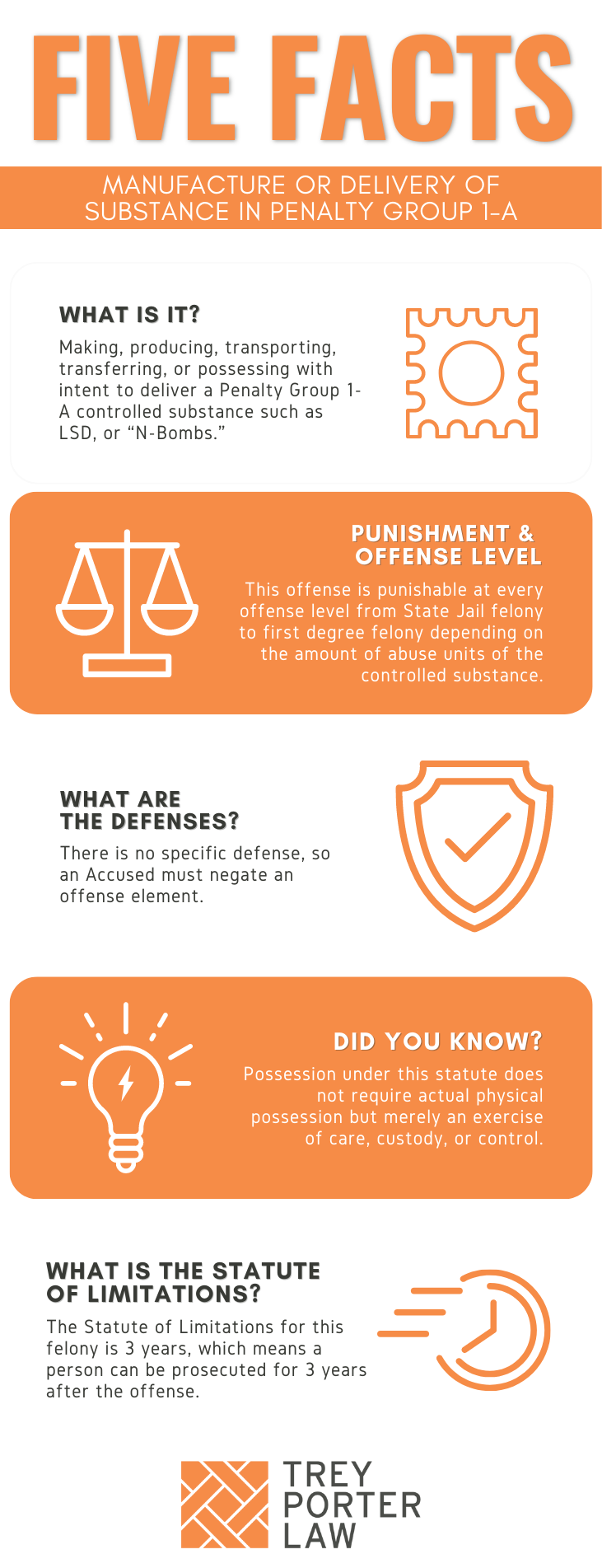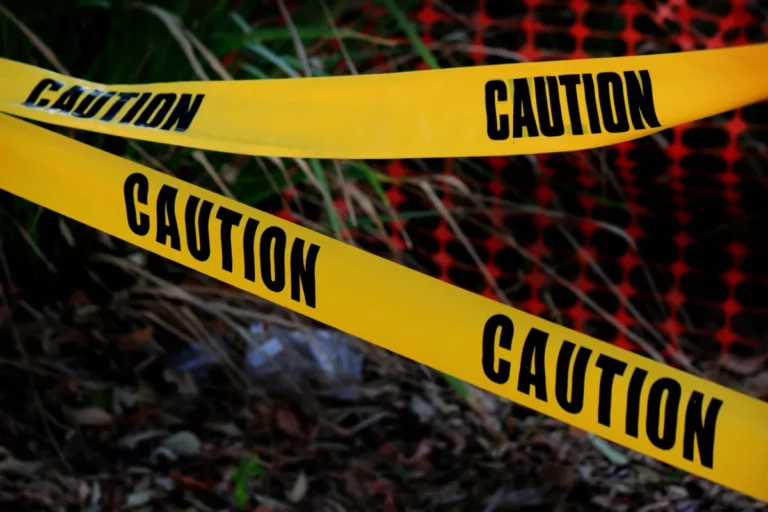WHAT IS MANUFACTURE OR DELIVERY OF SUBSTANCE IN PENALTY GROUP 1-A IN TEXAS?
The Texas law against manufacture or delivery of substance in Penalty Group 1-A prohibits making, producing, transporting, transferring, or otherwise possessing with the intent to deliver a controlled substance listed in Penalty Group 1-A.

- What is a controlled substance? Texas Health and Safety Code Section 481.002 defines a “controlled substance” as a substance, including a drug, listed in Schedules I through V or Penalty Group 1, 1-A, 1-B, 2, 2-A, 3, or 4. The term includes the aggregate weight of any mixture, solution, or other substance containing a controlled substance, but does not include “hemp” as defined by Texas Agriculture Code Section 121.001, or the tetrahydrocannabinols in hemp.
- What is the difference between Schedules I, II, III, IV, and V and the penalty groups of controlled substances? Controlled substances are divided into five “schedules” based on potential for abuse or addiction, which dictate the rules medical professionals must follow in prescribing medications listed in each schedule. Schedule I, for example, are the most addictive substances, and may generally not be prescribed. Substances in Schedule I are also typically in Penalty Group 1, and are considered illegal under most circumstances.
Controlled substances are divided into “penalty groups” for determining criminal classification and penalties.
- What controlled substances are in Penalty Group 1-A in Texas? Texas Health and Safety Code Section 481.1021 lists the following controlled substances in Penalty Group 1-A:
-
- lysergic acid diethylamide (LSD), including its salts, isomers, and salts of isomers; and
- compounds structurally derived from 2,5-dimethoxyphenethylamine by substitution at the 1-amino nitrogen atom with a benzyl substituent, including compounds further modified by:
- substitution in the phenethylamine ring at the 4-position to any extent (including alkyl, alkoxy, alkylenedioxy, haloalkyl, or halide substituents); or substitution in the benzyl ring to any extent (including alkyl, alkoxy, alkylenedioxy, haloalkyl, or halide substituents); and
- compounds such as:
- 4-Bromo-2,5-dimethoxy-N-(2-methoxybenzyl)phenethylamine (trade or other names: 25B-NBOMe, 2C-B-NBOMe);
- 4-Chloro-2,5-dimethoxy-N-(2-methoxybenzyl)phenethylamine (trade or other names: 25C-NBOMe, 2C-C-NBOMe);
- 2,5-Dimethoxy-4-methyl-N-(2-methoxybenzyl)phenethylamine (trade or other names: 25D-NBOMe, 2C-D-NBOMe);
- 4-Ethyl-2,5-dimethoxy-N-(2-methoxybenzyl)phenethylamine (trade or other names: 25E-NBOMe, 2C-E-NBOMe);
- 2,5-Dimethoxy-N-(2-methoxybenzyl)phenethylamine (some trade and other names: 25H-NBOMe, 2C-H-NBOMe);
- 4-Iodo-2,5-dimethoxy-N-(2-methoxybenzyl)phenethylamine (some trade and other names: 25I-NBOMe, 2C-I-NBOMe);
- 4-Iodo-2,5-dimethoxy-N-benzylphenethylamine (trade or other name: 25I-NB);
- 4-Iodo-2,5-dimethoxy-N-(2,3-methylenedioxybenzyl)phenethylamine (trade or other name: 25I-NBMD);
- 4-Iodo-2,5-dimethoxy-N-(2-fluorobenzyl)phenethylamine (trade or other name: 25I-NBF);
- 4-Iodo-2,5-dimethoxy-N-(2-hydroxybenzyl)phenethylamine (trade or other name: 25I-NBOH);
- 2,5-Dimethoxy-4-nitro-N-(2-methoxybenzyl)phenethylamine (trade or other names: 25N-NBOMe, 2C-N-NBOMe); and
- 2,5-Dimethoxy-4-(n)-propyl-N-(2-methoxybenzyl)phenethylamine (some trade and other names: 25P-NBOMe, 2C-P-NBOMe).
WHAT IS THE MANUFACTURE OR DELIVERY OF SUBSTANCE IN PENALTY GROUP 1-A LAW IN TEXAS?
Tex. Health & Safety Code § 481.1121. MANUFACTURE OR DELIVERY OF SUBSTANCE IN PENALTY GROUP 1-A.
(a) Except as provided by this chapter, a person commits an offense if the person knowingly manufactures, delivers, or possesses with intent to deliver a controlled substance listed in Penalty Group 1-A.
(b) An offense under this section is:
(1) a state jail felony if the number of abuse units of the controlled substance is fewer than 20;
(2) a felony of the second degree if the number of abuse units of the controlled substance is 20 or more but fewer than 80;
(3) a felony of the first degree if the number of abuse units of the controlled substance is 80 or more but fewer than 4,000; and
(4) punishable by imprisonment in the Texas Department of Criminal Justice for life or for a term of not more than 99 years or less than 15 years and a fine not to exceed $250,000, if the number of abuse units of the controlled substance is 4,000 or more.
WHAT IS THE PENALTY CLASS FOR MANUFACTURE OR DELIVERY OF SUBSTANCE IN PENALTY GROUP 1-A IN TEXAS?
The penalty classification for manufacturing or delivering a controlled substance in Penalty Group 1-A depends on the number of abuse units manufactured, delivered, or in the person’s possession.
- What is an abuse unit? Texas Health and Safety Code Section 481.002 defines an “abuse unit” as:
-
- a single unit on or in any adulterant, dilutant, or similar carrier medium, including marked or perforated blotter paper, a tablet, gelatin wafer, sugar cube, or stamp, or other medium that contains any amount of a controlled substance listed in Penalty Group 1-A, if the unit is commonly used in abuse of that substance; or
- each quarter-inch square section of paper, if the adulterant, dilutant, or carrier medium is paper not marked or perforated into individual abuse units; or
- if the controlled substance is in liquid or solid form, 40 micrograms of the controlled substance including any adulterant or dilutant.
For example, an abuse unit of 25I-NBOMe (“N-Bomb,” or “Smiles”), a synthetic hallucinogen, is a small square stamp meant to be placed under the tongue.
The penalty class for manufacturing or delivering a controlled substance in Penalty Group 1-A is a:
- State jail felony, punishable by 180 days to two years in a state jail facility, if:
- the number of abuse units is fewer than 20;
- Second degree felony, punishable by two to 20 years in prison, if:
- the number of abuse units is 20 or more but fewer than 80;
- First degree felony, punishable by five to 99 years or life in prison, if:
- the number of abuse units is 80 or more but fewer than 4,000;
- First degree felony, punishable by 15 to 99 years or life in prison, if:
- the number of abuse units is over 4,000.
Texas Health and Safety Code Section 481.134 increases the minimum prison sentence by five years and doubles the fine for manufacture or delivery of a controlled substance in Penalty Group 3 or 4 categorized as a felony, other than a state jail felony, if the offense was committed in a “drug-free zone.” The offense may be increased to the next highest category if committed within an institution of higher learning, within 300 feet of a public swimming pool or arcade, or within 1,000 feet of a residential treatment center.
- What is a drug-free zone in Texas? Texas Health and Safety Code Section 481.134 describes a drug-free zone as:
-
- in, on, or within 1,000 feet of premises of a school (including a day-care center), of premises owned, rented, or leased by an institution of higher learning, the premises of a public or private youth center, or a playground;
- on a school bus; or
- in, on, or within 1,000 feet of premises owned, rented, or leased by a general residential operation operating as a residential treatment center.
WHAT IS THE PUNISHMENT RANGE FOR MANUFACTURE OR DELIVERY OF SUBSTANCE IN PENALTY GROUP 1-A IN TEXAS?
The punishment range for manufacturing or delivering a controlled substance in Penalty Group 1-A corresponds to the penalty classification, which depends on the number of abuse units.
- 4,000 abuse units or more (first degree felony):
- 15 to 99 years or life in prison, maximum $250,000 fine; or
- 80 units or more but less than 4,000 units (first degree felony):
- five to 99 years or life in prison, maximum $10,000 fine;
- 20 units or more but less than 80 units (second degree felony):
- two to 20 years in prison, maximum $10,000 fine;
- Less than 20 units (state jail felony):
- 180 days to two years in a state jail facility, maximum $10,000 fine.
WHAT ARE THE PENALTIES FOR MANUFACTURE OR DELIVERY OF SUBSTANCE IN PENALTY GROUP 1-A IN TEXAS?
A person charged with manufacturing or delivering less than 20 units of a substance in Penalty Group 1-A is eligible for probation after a conviction, or deferred adjudication without a conviction, for a period between two to five years, with the possibility of extending supervision for up to ten years.
A person charged with manufacturing or delivering between 20 units and 4,000 units of a controlled substance in Penalty Group 1-A may be eligible for probation after a conviction, or deferred adjudication without a conviction, for a period not to exceed ten years. A person may only receive probation from a jury after a guilty finding if the person has no prior felony convictions, and the jury assessed a prison sentence of ten years or less.
WHAT ARE THE DEFENSES TO MANUFACTURE OR DELIVERY OF SUBSTANCE IN PENALTY GROUP 1-A IN TEXAS?
The statute does not authorize specific defenses to manufacture or delivery of a controlled substance in Penalty Group 1-A, and the exemptions in Texas Health and Safety Code Section 481.111 do not apply. A person accused of manufacturing or delivering a substance in Penalty Group 1-A may attempt to negate at least one of the elements the State must prove at trial.
- What is proof of intent to deal drugs in Texas? To convict a person of the higher offense of possession with intent to deliver a controlled substance, the State must show the accused possessed drugs for a purpose other than personal use. This may be shown by circumstantial evidence, the high volume of drugs, or any admissible statements the accused made during the investigation.For example, in Vega v. State, the defendant was sitting in the driver’s seat of a car with his wife when police approached. They saw marijuana in plain view, searched the car, and found a backpack on the floor when his feet were. Inside the backpack, police found ten baggies of methamphetamine. The backpack also had the defendant’s wallet and other possessions. He was convicted of possession with intent to deliver a controlled substance in PG1 (methamphetamine), and the appellate court affirmed.
- Is a lab test required for drug cases in Texas? Generally, yes. A person should not be convicted of possessing, manufacturing, or delivering a controlled substance in a specifically alleged penalty group without a lab report verifying the drug was the controlled substance alleged.In Ex parte Saucedo, the defendant was indicted for possession of methamphetamine, a controlled substance in Penalty Group 1. He pled before the lab results were sent to the prosecution, and was sentenced. The lab report revealed the defendant was actually in possession of methylethcathinone, a substance in Penalty Group 2. The Court of Criminal Appeals granted habeas relief, and cautioned all trial attorneys and defendants against pleading without all the evidence.
- What is drug possession in Texas? Texas Health and Safety Code Section 481.002 defines “possession” as actual care, custody, control, or management. Possession does not require proof a person is physically holding the controlled substance.In Rodriguez v. State, No. 04-21-00503-CR, the defendant’s girlfriend let her friend drive the defendant to the store. Police stopped the car while the defendant was in the passenger seat, and found 0.18 grams of methamphetamine in a chewing tobacco tin in the glove box. The officer noticed tobacco around the defendant’s mouth, so he was charged with and convicted of possession less than a gram of a controlled substance in Penalty Group 1.The appellate court affirmed. The drugs were conveniently accessible to the defendant on his side of the car, they were in a tobacco tin, and the defendant chewed tobacco.
- What is a search incident to arrest in Texas? The Fourth Amendment to the U.S. Constitution permits police officers to conduct warrantless searches incident to lawful arrests. The justification for permitting such a warrantless search is: (1) the need for officers to seize weapons or other things which might be used to assault an officer or effect an escape; and (2) the need to prevent the loss or destruction of evidence. See State v. Granville, 423 S.W.3d 399, 410 (Tex. Crim. App. 2014).In State v. Sanchez, an officer approached the defendant’s jeep, which was parked in a grassy area next to a bar with the driver’s door open, the engine turned off, and the defendant was asleep in the driver’s seat. The officer woke the defendant up to check on him, and learned he had traffic warrants. Incident to arrest, the officer searched the defendant’s pockets, and he had cocaine. He was then arrested for possession of a controlled substance in PG 1, his car was searched incident to that arrest, and more cocaine was found. The appellate court upheld the car search as a valid search incident to his arrest for possession.In Botello v. State, police responded to an assault-in-progress. The officer spoke to the victim outside the home, who said the defendant was her estranged husband, had assaulted her, and was still inside. The defendant refused to come out, but the victim consented to a search of the home, so police forcefully went inside. Officers immediately arrested the defendant for assault, searched his pockets, and found over 24 grams of heroin. He was convicted of possession of a controlled substance in PG 1, and the appellate court affirmed.
WHAT IS THE STATUTE OF LIMITATIONS FOR MANUFACTURE OR DELIVERY OF SUBSTANCE IN PENALTY GROUP 1-A IN TEXAS?
The limitation period for manufacturing or delivering a substance in penalty group 1-A is three years.
MANUFACTURE OR DELIVERY OF SUBSTANCE IN PENALTY GROUP 1-A IN TEXAS
Texas punishes manufacturing, cooking, growing, transporting, delivering, or otherwise possessing with the intent to deliver a controlled substance in Penalty Group 1-A in any amount as a felony.
TEXAS MANUFACTURE OR DELIVERY OF SUBSTANCE IN PENALTY GROUP 1-A COURT CASES
The case law regarding manufacture or delivery of substance in Penalty Group 1-A in Texas gives examples of evidence supporting a conviction.
- In State v. Sirucek, Port Aransas police officers were notified that the defendant was selling “molly,” or MDMA, a controlled substance in Penalty Group 2, out of his car. Police brought their drug dog to the defendant’s suburban, who alerted to the presence of narcotics, which gave them probable cause to search. In the suburban, police found 88 grams of MDMA, and 81 units of LSD. He was convicted of possession of a controlled substance in PG 2, and PG 1-A, and the appellate court affirmed both convictions.
- In Johnson v. State, the defendant was staying in his mother’s home, and his mother called police for an unrelated suspicion of burglary. Police arrived and saw drugs in the defendant’s room, and got consent from his mother to search the room. They found 150 units of 25I-NBOMe, guns, a scale, marijuana, and methamphetamine. He was convicted of possession of a controlled substance in PG 1 (for the meth) and PG 1-A with intent to deliver, and the appellate court affirmed.
















